Many gardeners and gardeners have long ceased to concentrate all their attention exclusively on the cultivation of agricultural and vegetable crops and turned their eyes towards the flowers. , created by one's own hands - this is the observance of certain principles and rules, this is painstaking work, the result of which is an ideal flower garden.
At the same time, the question naturally arises - how to properly form a flower bed so that it looks harmonious and what flowers to choose for it?
Perennial flowers - the basis for creating a flower bed
There are two major varieties of flowers. The first group is those that are planted with seeds and grow within just one season. The second group is perennials, plants that require more care, but at the same time are able to please the gardener for several years.
Perennial plants have a number of advantages that are valued among lovers of growing flowers on the site:
- a large species diversity, which is very important when a flower bed is created;
- long life of the plant. Only the upper part dies off, and the roots are able to exist for more than 6 years in some plants;
- reproduction using rhizomes, shoots or seeds, which allows you to later transplant flowers into other flower beds and create additional flower beds;
- a large number of medicinal plants in list perennial species, which makes it possible to get a real "green" pharmacy in the country.
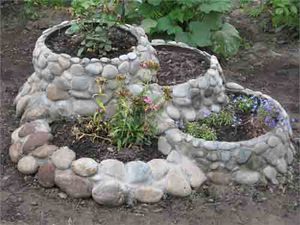
Rules for creating a flower bed
The very process of developing and creating a flowering flower bed on the site can be compared with art, since even at the design stage it is necessary to take into account how the flower garden will look in different time of the year. A properly created flower garden is when new species of plants replace the fading plant species and so it persists throughout the summer.
Creation planning flowering area required upon completion general zoning homestead territory, when the locations of the beds, paths will be distributed, shrubs and trees will be planted.
When creating a flower bed, you should pay attention to:
- climate. When choosing plants, you should focus on species that will feel comfortable in the selected climate zone;
- site features. Using the terrain will help not only to correctly use free space, but also allow you to create interesting options registration;
- the nature of the soil. Another important parameter, which will influence the choice perennials. Fertile soil is ideal for, mallow, bluebell. Loam, sand or rocky soil will be convenient for growing flax, valerine,. swampy soil suitable for, nivyanik, yarrow. Too dry land - a place for cultivation, cosmea, carnations or gaillardia;
- site illumination. Where the sun is more than 6 hours during the day, you can grow peony, poppy, aster, phlox. If light access is limited to an interval of 4 to 6 hours, then it is best to choose plants such as astilba, iris, aquilenia, primrose. Ferns, lily of the valley, hosta are suitable for shady flower beds.
- planting density and flowering time. You should not unnecessarily part when planting plants, as they can simply "clog" each other.
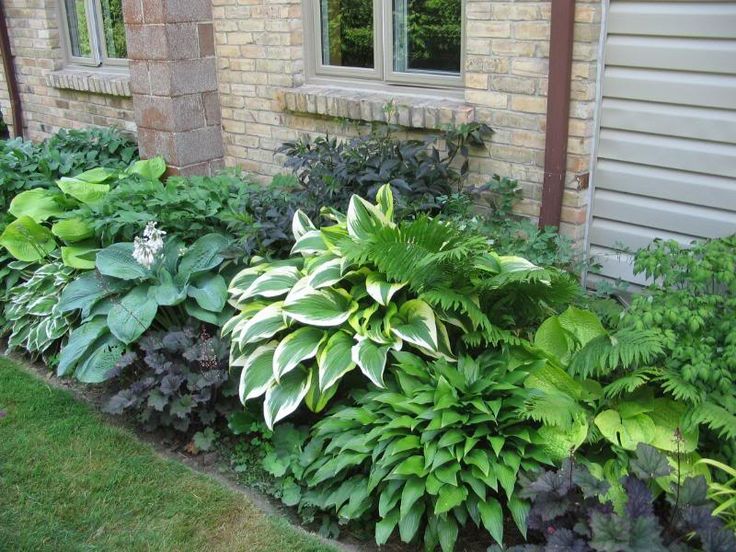
Hostas and geyhers are an amazing option for creating a shady flower bed. You can get by with only varieties of these two crops - they are so diverse that they are enough to create a colorful canvas.
The combination of colors is an important factor when creating a flower bed
Psychologists have long established that color greatly affects the human condition and this applies to all spheres of life. That is why, when creating a flower garden from perennial plants, increased attention is paid to this parameter. A competent combination of colors will achieve aesthetics in the flower bed. When distributing colors, it will be useful to familiarize yourself with general principles creating a palette and mixing shades:
- the color combination largely depends on the play of light and shadow, so the presence of smooth leaves in plants will reflect light, and dull ones will absorb;
- when choosing the unity of the brightness of colors, it is necessary to apply only one color palette, either warm or cold;
- in order to visually increase the size of a small flower bed, it is necessary minimize the number of colors on it and get rid of excessive contrast;
- to visually increase the size of the flower garden, you can arrange blue flowers in the background, and yellow or red species in the front;
- the more saturated the foreground of the flower bed, the more calm the back should be;
- when creating not a single flower bed, but a whole flower garden, it is recommended to use desaturated shades as a background, such as white, pink or blue. Contrasting flowers should be placed in small groups that will occupy no more than a sixth of the total space;
- according to the rules of floristry in the territory of one garden it is not allowed to have more than one flower bed with bright colors . You should also avoid excessive contrasts in the design;
- with its own saturated color of the main plant at the club, it can be diluted with more neutral shades;
- landing area should be measured different colors . On a blue background, a small red spot will look appropriate, and an enlarged one will simply annoy;
- the main color of the composition is advised to choose in accordance with the purpose of the flower garden and its location, namely the climatic zone. It has also been noticed that the urban dweller is more prone to natural shades, while the rural one prefers bright colors that are almost impossible to find in nature.
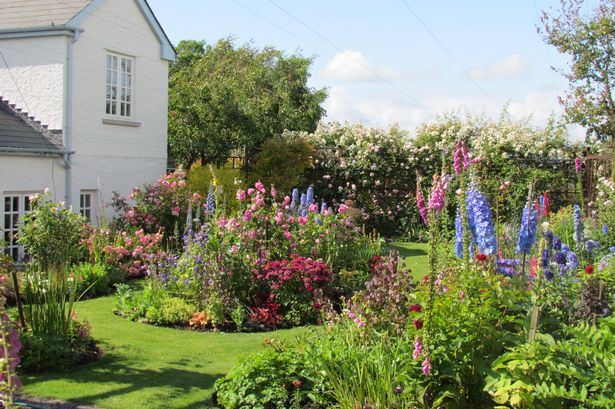
Not large flower bed with high delphiniums - a rare and difficult option, in this case it does not look bulky due to the environment ( tall trees, curbs, building).
Schemes of simple flower beds for beginners
Modern flower beds can have various geometric shapes, while there is a difference in two large groups - flower beds with regular and irregular compositions.
- Regular Composition suggests the presence of a clear geometric pattern, while all the plants in such a flower garden bloom at the same time and there are clear boundaries between them.
- irregular composition differs in grouping plants and inscribing a flower garden into the landscape. It is for flowerbeds with irregular compositions that perennial plants that can bloom alternately will be the most optimal, which will increase the flowering time.
Ready-made schemes will help create the right flower bed that will please the eye and allow you to pick up optimal choice plants for her. In this case, regardless of the chosen form, there is general pattern planting flowers in a flower bed. The brightest and tallest specimens are in the center, the middle part is a place for plants medium height, and at the edges should be located undersized perennials long-flowering or just an ornamental grass.
- Rectangle. A flower bed that has a clear rectangular shape. At the same time, a pattern can be created inside from a combination of various plants.
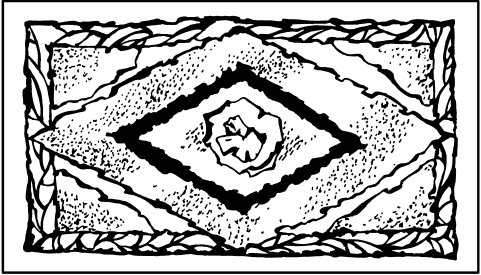
- Oval. The next simple option is an oval flower bed. In this type of scheme, the center of the flower garden and zonal division are very clearly visible.
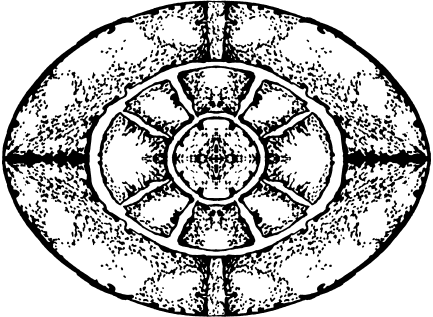
- A circle. Third simple figure, which can become a form for a flower bed. Round flower beds are most often used on garden plots, since with this form access to all plants is facilitated, which simplifies care.
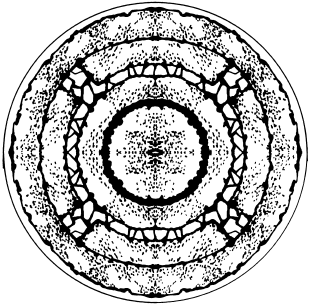
- Triangle. An unusual and not the most standard form for a flower bed, which can be used if necessary to “fit” a flower garden into a certain limited space.
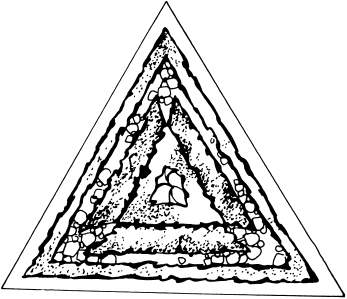
In addition to the four main geometric shapes, which can be easily mastered by beginners, there are concrete examples flower garden schemes:
- Round flower bed "Spring Symphony". At number 1 - pink mattiola, 2 - red zinnia, 3 - white verbena. In this version, there are only three shades - red, pink and white, which in no way affects the appearance.
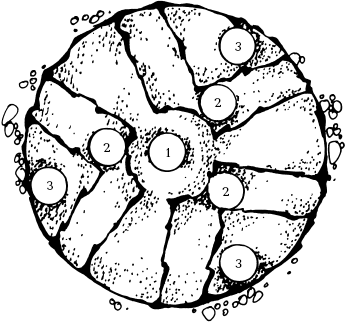
- concentric flower bed, consisting of regular concentric circles that are easy to draw on your own. In this variant, the following flowers are present: 1 - dark-leaved cannes, 2 - fluffy gnafalium, 3 - perilla nankinensis.
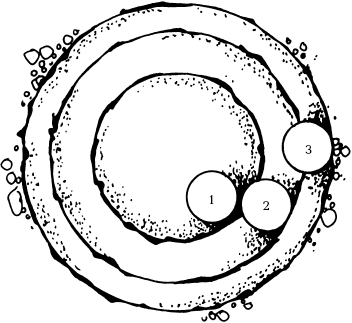
- Contrasting flowerbed "White and pink". A simple square flower bed, which will be dominated by white and red shades. Among the flowers there will be the following representatives of perennials: 1 - leucanthemum, 2 -, 3 - white delphinium, 4 - physostegia, 5 - phlox, 6 - arabis, 7 - clematis, 8 - armeria, 9 - daylily, 10 - irises, 11 - lupine , 12 - obrietta.

- Shade-loving flowerbed "Colors of summer". A feature of this flower garden is the predominance shade-loving plants. To design a flower bed you will need: 1 - common primrose, 2 - Arends' astilbe, 3 - periwinkle, 4 - bell, 5 - badan, 6 - large-leaved brunner, 7 - toothed buzulnik, 8 - purple foxglove.
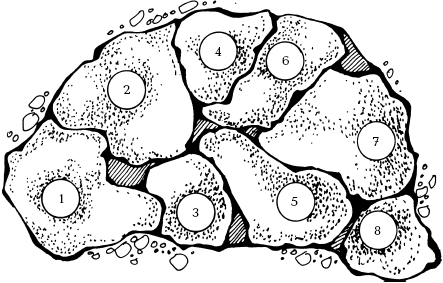
AT recent times high flower beds, which are created in specially made boxes just below a meter high, are widely used. Such a flower bed is easy to care for, fewer weeds grow on it, but at the same time the process of its creation is more complex and troublesome.
Sometimes there is a need to create a flower bed in low light conditions, for example, in the shade of a fence or along the wall of a house. In this case, you should select plants that can grow with a small amount of natural color. You can create flower beds in accordance with the following schemes:
- shady flowerbed. It includes: 1 - badan; 2 - thimble, 3 -, 4 - soft cuff; 5 - variegated, 6 -.
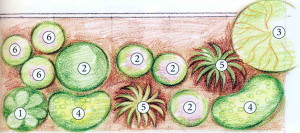
- flower garden located along the north side of the house. The following plants will be present in such a flower bed: 1, 2, 3 - hosta different varieties, 4.5 - western thuja, 6 -. Also a popular perennial that blooms from April to May;
- doronicum plantain. A plant ideal for wet and shady places. Also applies to primroses;
- the bell is crowded. A flower that also grows well in the shade. Color appears in June;
- meconopsis. A plant that requires a minimum of care, consisting in the removal of fading buds. Blooms from May to June;
- hellebore. A flower that feels best in conditions of fertile soil and shade;
- musky mallow. A perennial that is not susceptible to growing conditions and feels good even in the shade. Blooms from early summer to September;
- . Ground cover plant of the succulent family. Flowering period from July to September;
- function. A decorative leafy plant that can be used in a flower bed as a green mass;
- . A plant known to many, capable of gaining color again when pruned. Blooms from June to late August
- rose garden in cold colors. The whole flower bed is made in cold pink and lilac tones, which evokes a feeling of freshness and coolness. The following flowers are present on the diagram: 1 - chistets, 2 - gerhera, 3 -, 4 - William Shakespeare rose, 5 - Queen of Sweden rose, 6 - clematis, 7 - Gertrude Jekyll rose, 8 - Mary Rose rose.
- contrasting rosary. A flower bed built on the use of red and white color with a shrub background that blooms throughout the summer. When decorating, the following plants are used: 1 - hosta, 2 - rose Gartnerfreunde , 3 - verbascum, 4 - Aspirin Rose rose, 5 - Hansaland rose, 6 - panicled hydrangea, 7 - Amadeus rose, 8 - Schneewittchen rose, 9 - horizontal, 10 - dwarf spruce.
Shady flowerbed-border with meconopsis, primrose, hostas.
The selection of a plant in the space of one flower bed will allow you to get a flower garden that will delight with a riot of colors throughout the summer season.
Labor-intensive perennial flowers for growing in a flower bed
Labor-intensive crops include those that will require regular care, the creation of special conditions for growth. Also, plants in this category often get sick, are unstable to changes in climatic conditions, and are prone to disease. This group includes most of the representatives bulbous plants, lilies, roses, gladioli, dahlias, hyacinth, kempfera, evening primrose, begonia.
Mixed rose garden - a variant of the perfect combination of roses and perennials
The term "" is commonly understood as a flower bed where only roses are grown. But in middle lane In Russia, where summer does not differ in duration, it is customary to create mixed rose gardens, where various perennial plants find their place in the flower garden, which allows you to structure the flower bed. There are several simple circuits mixed rosary design:
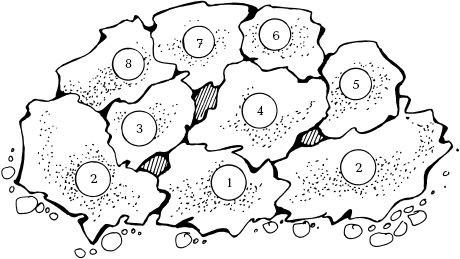
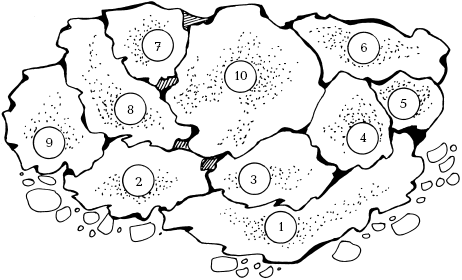
Flowerbed for the lazy - what is it
For those who wish to enjoy passive recreation on their personal plot, but at the same time receive aesthetic pleasure, there is a concept - “a flower bed for the lazy”. In such a flower garden, plants are collected that practically do not require care and are not demanding on watering or top dressing. In this case, the duration of flowering can last from early spring to autumn.
Most often, online stores selling flowers are ready to offer customers who do not have time to get acquainted with the nuances of growing plants, already ready-made options, including flowerbed layout diagrams with descriptions of flowers.
A specific option could be oval shape a flower garden in which they will be located: in the center - peonies, astilba in front of them, stonecrop on the right edge, geraniums on the left, and all this will be bordered by hosta or badan. You can also plant an aster or phlox on this flower bed, which will only add color brightness.
Price similar project will cost about 600-700 rubles, while the most expensive will be peonies, which are best purchased in the form of seedlings.
A feature of the option is continuous flowering separate species plants. In this case, the flower bed itself will not differ in particular brightness, but there will be a stability of the appearance flowering plants.
Plants that are also suitable for a lazy flower bed include irises, daffodils, phloxes, daylilies, clematis, lupins, or leucanthemums. At the same time, in this case, it is not required to create a variety of planted varieties or species, since the greater the number of flowers, the more care will be required.
The photo below shows an example of a corner flower bed with. 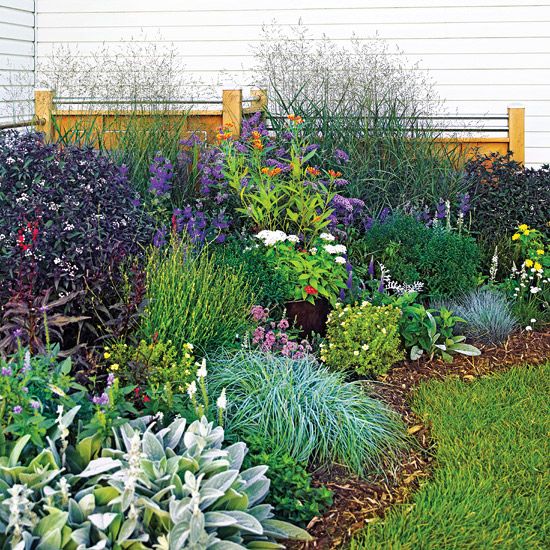
video consultation
The layout scheme and the desired image are well thought out. Now it is important to choose the plants correctly, having previously familiarized yourself with their care requirements. The video below is an overview of the most spectacular and unpretentious perennials, with recommendations for their successful cultivation.
In order to make flower beds in the country from perennials with your own hands, it is not necessary to be a certified specialist in landscape design or have higher education. It is enough just to remember all the tips and recommendations, and take them into account. And with experience (and with a few flower beds), skill will definitely come.
What to plant perennial flowers in the country?
A flowerbed of constant flowering from perennials is very easy to decorate with your own hands even the most unprepossessing personal plot, giving the landscape a unique charm. Geraniums, roses, asters, poppies and carnations will grow in one place year after year without requiring much attention.
A question that any novice gardener should know - choice of flowers for a perennial flower bed. Taking into account practical experience, the first flower garden must be made small, preferably from stone, and planted with unpretentious plants that grow well in the sun.
The flower bed is a bright element personal plot, therefore it makes no sense to hide it under the shade of trees or equip it in the far corner. best solution for the arrangement of a perennial flower bed there will be a well-visible place from all sides. Tiered flower beds (with low-growing exhibits in the foreground and tall exhibits in the background) are best placed near hedges, fences, or house walls. At the same time, in the middle of the plot, an all-time flowering flower bed of perennials can both have various color combinations, and be decorated with only one kind.
DIY flowerbed for beginners
 Tall plants for the center of the composition: astilbe, roses, asters, lilies, peonies, clarikia, Hassler's cleoma, black cohosh, ornamental onions, delphinium, gelenium, phloxes, multi-leaved lupine, Ruselovsky gooseberry, hosta, clematis, rudbeckia, hydrangea, poppy, spiked liatris , ratibida columnar, meadow bells, daylily, echinacea and so on.
Tall plants for the center of the composition: astilbe, roses, asters, lilies, peonies, clarikia, Hassler's cleoma, black cohosh, ornamental onions, delphinium, gelenium, phloxes, multi-leaved lupine, Ruselovsky gooseberry, hosta, clematis, rudbeckia, hydrangea, poppy, spiked liatris , ratibida columnar, meadow bells, daylily, echinacea and so on.
Medium growing perennials for addition: anemone, tulips, fragrant rue, irises, aquilegia, dyeing navel, mountain cornflower, beautiful small-flowered, magnificent dicentra, hybrid catnip, gravel, oak sage, geyhera, ptarmica yarrow, narrow-leaved lavender, bergenia, fern, primrose, quadrangular primrose and so on.
Ground-covering flowers for filling the gaps and edging the flower beds: acena, Byzantine chistets, creeping tenacity, periwinkle small, obrieta, Renard's geranium, carnation-grass, Carpathian bell, spring umbilical, lobularia, small periwinkle, waldsteinia, lungwort, veronica and others.
Tall plants are best plant separately, but it is advisable to plant small plants in groups, several copies at a time. Moreover, in a flower bed, which is viewed from various angles, higher flowers should be planted closer to the middle, and small ones along the edges.
In order to prevent weeds from growing in the flower bed and not gaping bald spots, plant your flowers closer to each other, but not very crowded.
Do you want to achieve permanent flowering? Learn about the characteristics of each plant, write down the flowering time on paper and draw up your plan. beautiful flower garden from perennials, where some flowers will bloom in the spring, the second - in the summer, and the third - by the end of autumn.
Perennial flower beds - the best schemes
The first scheme "The most simple":
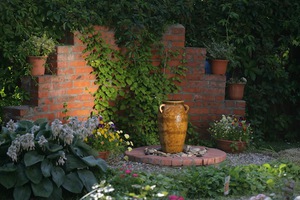
Second scheme"A flowerbed of perennials that bloom in the first year":
- ten-petal sunflower (rather valuable variety that blooms from August to mid-October, has healing properties and grows well)
- rose "Pleniflora" with terry corollas of red-purple, salmon-pink and yellow flowers ("Pleniflora" is just a giant mallow, blooming profusely on moist and sunny areas garden from the beginning of summer until the first cold snaps);
- St. John's wort "Hidcote" ("odorless" variety of St. John's wort pleases yellow flowers in the flowerbed from July to August);
- Icelandic poppy (great for an ever-blooming perennial bed, thanks to continuous flowering from June to late autumn);
- catnip "Nepeta faassenii" (blooms for a long time with flowers similar to lavender, from the beginning of May);
- cardinal lobelia (a flower with a beautiful leaf, these flowers adorn the site from June to September);
- geikhera "Miracle" ( beautiful bush with an unusual shade of foliage, decorated with pink-hued flowers from May to mid-June);
- katananhe "Blue Cupid" (flowers-baskets of sky-muted color can be observed the whole summer);
- bell "Campanul poscharskyan" (crystal ringing of such delicate and fragile flowers of blue and purple hue can be heard from May to August);
- sedum "Matrona" (a strong bush with beautiful flowers can be seen until the first snow);
- perennial gravel (in the composition of a perennial flower bed, this herbaceous plant does not solo, but most likely simply complements the flowerbed from June to August).
Third scheme "Beautiful pink-purple flower bed":
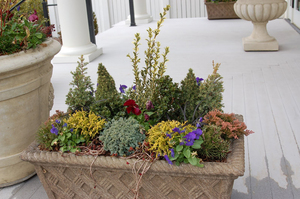
Creating a flower garden with your own hands: soil preparation and planting flowers
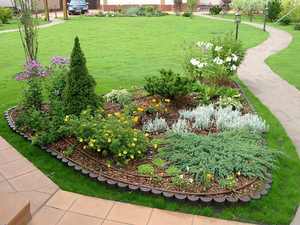 After reviewing the photo and deciding on the composition for the flower garden, it's time start preparing the ground under the flower bed This is the most time-consuming task in the construction of a perennial flower garden, but at the same time the most necessary, since properly prepared land is the foundation of a future flower garden.
After reviewing the photo and deciding on the composition for the flower garden, it's time start preparing the ground under the flower bed This is the most time-consuming task in the construction of a perennial flower garden, but at the same time the most necessary, since properly prepared land is the foundation of a future flower garden.
It is necessary to prepare the soil after you make a sketch of the future flower bed. It is necessary to select plants not only by photo and flowering time, but also by similar requirements for light, soil and moisture - this is essential make gardening easier. (For example, in semi-shady and shady areas in dry areas with loose and fertile soil grow well: cuffs and lilies of the valley, Goryanka and geikhera, anemones and periwinkles, geraniums and irises, phloxes and primroses).
How to make a beautiful flower bed from perennials?
You need to start by removing the old soil with a shovel. Remove soil with roots and weeds, and reanimate the soil by diluting clay soil sand, and light soil - concrete or clay soil. Then add compost and loosen the soil as deeply as possible with a pitchfork, mixing compost, sand and clay. Add the required fertilizers and plant seedlings.
But keep in mind that in the flower garden of any scheme, per 1 sq. meter planted approximately:
- 8 pcs. undersized plants;
- 9 pcs. ground cover;
- up to 4 tall plants;
- 6 pcs. medium-sized.
Forms of flower beds and flower beds from perennial flowers
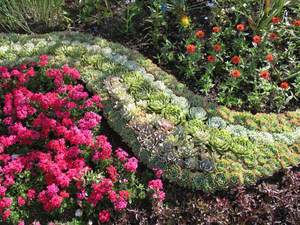 The classic forms of flower beds can be seen less and less in landscape design. In modern landscape gardens, island flower beds with asymmetric planting and height types of flowers, arranged on lawns and lawns, are more appropriate today. Vertical multi-level flower beds are also popular. Raised flower beds planted in pots also look original. interesting shapes, cascades of rectangular stands and mini-flower beds in old stumps, bordered by stone.
The classic forms of flower beds can be seen less and less in landscape design. In modern landscape gardens, island flower beds with asymmetric planting and height types of flowers, arranged on lawns and lawns, are more appropriate today. Vertical multi-level flower beds are also popular. Raised flower beds planted in pots also look original. interesting shapes, cascades of rectangular stands and mini-flower beds in old stumps, bordered by stone.
Tip: it is best that the shape of the flower garden is combined with the shape near the building, for example, a porch or a gazebo.
Round flower garden of perennials
If we consider the simplest method of decorating a flower garden with your own hands, then this, of course, is a round flower bed, which is quite simple to make on your own, taking any photo you like as a basis. But in this case, it is important to choose the right size. Since in a large area a small flower bed will look ridiculous, and a very voluminous flower garden within a limited space will look bad.
Need a place for a flower garden clear weeds, stones and debris. Break up large clods of earth, level the earth with a rake and dig up.
To clearly draw a circle, you need to take a peg, hammer it into the middle of the future flower garden and tie a cord, at the second end of which there will be another peg. They need to draw the correct circle of the required size.
Fourth scheme"Perennial flower beds for round flower beds":
- forget-me-not alpine or alpestris, often used to decorate borders;
- Levkoy "avalanche" or matthiola with large white flowers, neatly collected in inflorescences;
- pansies, namely the variety "V.T.Maxima" - tricolor violet which blooms all summer;
- red fescue with characteristically elongated linear, narrow leaves, which, intertwined, create a bright green continuous carpet;
- elegant zinnia or Zinnia legans with large flower heads;
- primrose or Primula veris - unpretentious plant, which blooms in spring with fragrant yellow flowers;
- Achyranthes verschaffelti, his large leaves, usually used landscape designers for arranging patterned flower beds;
- "Aurea nana" or alternantera with golden green oblong leaves.
If you didn't like it flowering of certain plants in the flower garden - look at the photo and improve it, remove what disappointed and plant it on free place new plants. The land of your plot in the country is not a place that can be clogged, the garden should always please you.
Beautiful and well-groomed flower bed - worthy decoration any plot, and a flower garden continuous flowering- also a testament to the talent of its organizer.
To ensure that plants bloom by replacing one another during one season or all year round, is worth considerable work, in particular, knowledge of the characteristics of the vegetation of planted plants and the presence of artistic taste in the gardener.
For those who want to create such a flower bed, we offer advice and experience. experienced agronomists from this article.
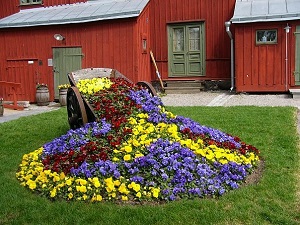
The fantasy regarding the shape of the flower beds can be limited only by the size and characteristics of the plot of land on which the flower garden is to be laid.
There are no restrictions either in a horizontal or vertical arrangement: a circle or a square, a rectangle or an oval, an alpine hill or a green wall - everything that the owner likes.
Let us dwell in more detail on the consideration of horizontal flower beds and try to decide not only on the form, but also on the restrictions imposed on the selection of plants.
Circle and oval
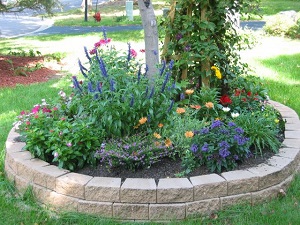
This geometry of flower beds, perhaps, is the most common due to the perfection of forms and the simplicity of the arrangement of plants.
Concentric circles or ovals that define the boundaries of groups of flowering plants make it possible to create compositions of amazing beauty when flowering, starting from the outer perimeter, gains strength and reaches a peak in the center.
The same forms allow plants to be grouped so that the flowering periods change in turn, giving the impression of iridescence.
Such figures are also good because radial paths naturally fit into them for caring for a flower garden. There are no restrictions on the choice of plants, since shrubs and tree species, and grassy at the edges.

Square and Rectangle
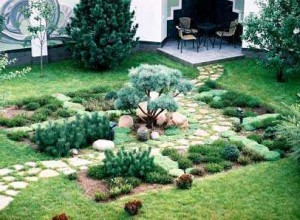
These simple shapes, are of interest for creating original and colorful ornaments inside the perimeter: broken polyhedrons or rounded compositions create a unique look for a flower bed.
In addition, the simple external geometry allows you to literally draw pictures or lay out a mosaic of low plants.
In this case, there are no obstacles to choosing perennial and annual plants: they can be placed in the center of the composition, and along the perimeter
triangle and star
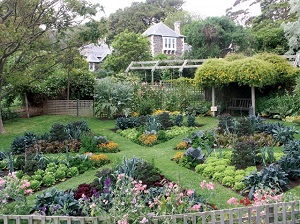
By themselves, single flowering triangles look less impressive than if you combine their shapes into groups of irregular geometry or, conversely, give them the correct graphic outlines, for example, stars. Such a flower garden will not leave anyone indifferent.
True, it’s worth tinkering with the selection of plants here: herbaceous perennial species (oak anemone, mountain arenaria, astilba, etc.) will become the most optimal and spectacular.
Irregular flower beds
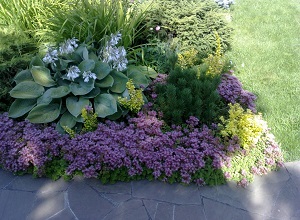
But still, irregularly shaped flower beds will be the most advantageous option for complementing and decorating.
The reasons for their success are that they fit perfectly into an uncomfortable landscape, help to avoid the "bald patches" formed by plants that do not bloom at some time.
Consider the features of the device of an asymmetric flower bed of continuous flowering:
First of all, the viewpoints of the flowerbed are determined, and based on this, the problem of plant grouping is solved. Planting is done in such a way that low plants are in the foreground, tall ones are in the background, which should not cover general form for a flower arrangement.
Note: planting height in an asymmetric flower garden should be 2 times shorter than the distance to the place where the view opens.
Plants are selected and combined into groups in accordance with the optimal conditions for their growth: illumination, soil composition, watering needs. Within the group, zones are formed in accordance with the flowering period. Uniformity in the volume of plants blooming at different times is observed.
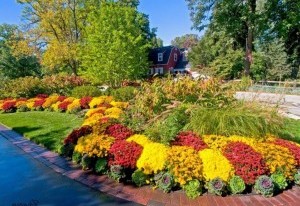
When forming the geometry of space, the speed of vegetation is taken into account different types. Selection of species is carried out in accordance with a certain color scheme. In one case, it will be a contrasting combination, in the other - a color gradient, and in the third - similar shades.
Places are determined from which it will be convenient to maintain and replace plantings. Faded plants often lose their attractive appearance.
Selection of plants for flower arrangements
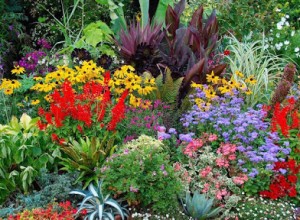
To reduce the time spent on updating groups of plants in the flower garden, mainly long-flowering plants, i.e. perennials, are selected. These include shrubs, woody and part of herbaceous plants.
In the center of the flower garden, where access is usually limited, they land tall perennials, care of which should not be frequent.
Note: conifers, evergreen viburnum and barberry perfectly play the role of a compositional center, which require rare pruning and at the same time retain their green pores throughout the year.
In the middle part of the flower bed, those plants are planted that are replaced every 2-3 years or less, and undersized perennials or annuals are placed around the perimeter of the flower beds. Any of the plant species used should have a relatively long time flowering.
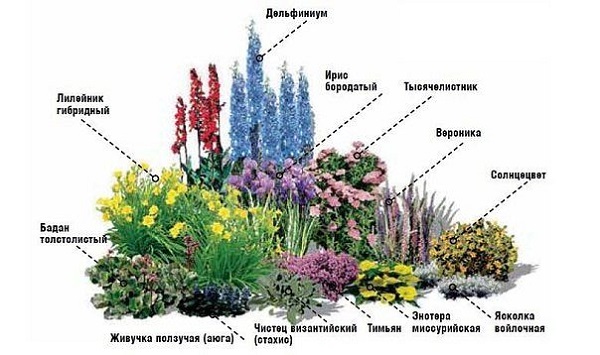
As a rule, when selecting plants for flower arrangements special attention is paid to those that have an interesting color of the leaves and colorful original fruits: they will also play a role in giving color and originality to the flower bed. This type of flowers includes, for example, physalis, and among the shrubs, the beautiful and snowberry stand out.
For the convenience of selecting perennial plants when planning a flower bed, the following table will be given:
| Name | Color spectrum | Height | flowering period |
| spirea | white | medium shrub | summer |
| hydrangea | purple pink shades | summer |
|
| viburnum | white | tall shrub | spring Summer |
| barberry | white | low and medium shrub | late spring |
| chaenomelis | deep pink | medium to tall shrub | early spring |
| forsythia | yellow | medium to tall shrub | early spring |
| juniper | shades of green | creeping perennial | all year round |
| honeysuckle | White yellow | liana or tall shrub | summer |
| mock orange | white | tall shrub | summer |
Stages of creating a flower bed

The flower garden bookmark has a strict sequence of actions, where each structural component has importance the end result of the process.
Haste in the matter of creating a flower garden is not needed. It is better to reinforce your knowledge in floriculture with fantasy and a clear list of actions.
Following the algorithm below, you can create an original and long-flowering flower bed:
- Planning of place and form. Before proceeding with the implementation of the plan for creating a continuous flowering flower bed on the ground, it will be useful to create a project made with paints on paper to understand how the flower garden will look like in reality. In designing the project, the period during which the plants will bloom should be taken into account. If you want aesthetic pleasure to stretch for whole year(if such a possibility exists in specific climatic conditions), then in addition to flowers and herbs, use shrubs and trees with an evergreen cover or with long flowering. The shape of the flower bed is chosen based on the landscape of the occupied site and the style of the building. The choice of plants for planting is also done at the design stage. The site is chosen so that the plants feel comfortable and receive at least five hours of sunlight per day.
- Perimeter marking and base preparation. Having decided on the shapes, sizes and composition of flowering plants, the project is transferred to the area. The basis is prepared accordingly:
- markings are applied to the surface of the earth using pegs and cords;
- the sod and part of the underlying cover is removed;
- drainage from sand and pebbles is arranged;
- a fertile enriched layer of soil is poured.
- Creation of a relief and preparation of the soil. If the flower bed is located not only in the vertical plane, but also in the horizontal one, then its levels are formed from pebbles, large stones that are sprinkled on top of the earth, forming tiers for planting not tall flowers. The composition of the soil depends on the composition of the plants. Each section provides the most optimal soil composition for each specific group of flowering plants. But in general, the soil should be sifted, devoid of rhizomes, large inclusions, enriched with fertilizers and compost.
- The marking of the pattern is carried out using a flexible wide tape or strips, which are buried in the soil with a small protrusion above the surface, strictly limiting the planting area of a particular group of flowers.
- Planting plants is the final stage in the process of forming a flower bed of continuous flowering. Plants are planted from the center to the perimeter, taking into account the subsequent vegetation. Tall species are planted singly, smaller ones in groups.
How to ensure continuous flowering?
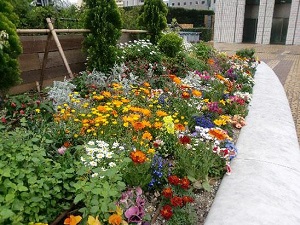
The continuity of flowering is ensured by the exact selection of plants and the diversity of species. The bulbs bloom first, so we plant, muscari, etc., not forgetting that some of them require the separation of the bulbs and replanting every few years.
From shrubs, we pay attention to chaenomeles, forsythia, from trees - decorative forms plums, magnolias, almonds. Further, later perennials enter the flowering phase: geranium, viola, daisies. We add to them felt cherry, roses, hydrangea and spirea.
All summer long, rudbeckia, monarda, zinnia, etc. bloom and delight the eye. At the end of summer, asters bloom. Autumn is the time for the flowering of chrysanthemums, the varied color palette of which does not tire of pleasing the eye for a long time.
How to properly care for a flower bed?
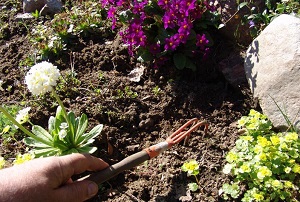
In order for the flower bed to constantly please the eye, competent care of the plants is necessary. Planned work includes:
- Regular watering.
- Plant pruning.
- Soil loosening.
- Removal of faded parts.
- Garter.
- Planting and updating.
- Feeding and spraying.
- Shelter for the winter.
With proper and planned care for flowers, ornamental bushes, herbs and ground cover species perennials, a flower bed of continuous flowering is ready to delight others with its bright colors during most of the year.
It's hard to imagine country cottage area no bright flowers. To enjoy the riot of colors throughout the warm period, it is not necessary to be an experienced landscape designer.
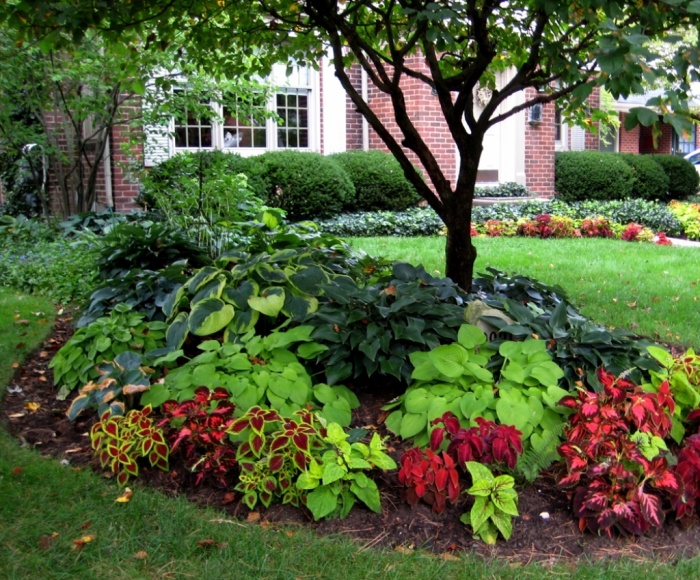
Principles of flower garden formation
Before proceeding with the improvement of the territory of the cottage, it is necessary to familiarize yourself with the fundamental principles of designing flower beds.
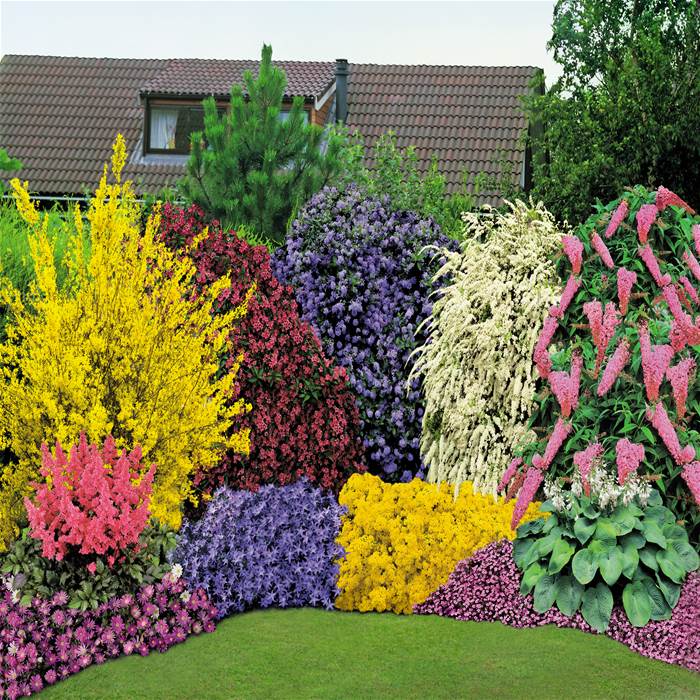
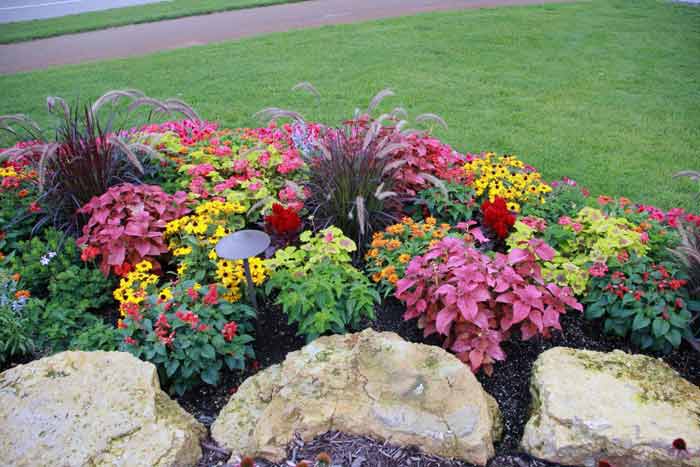
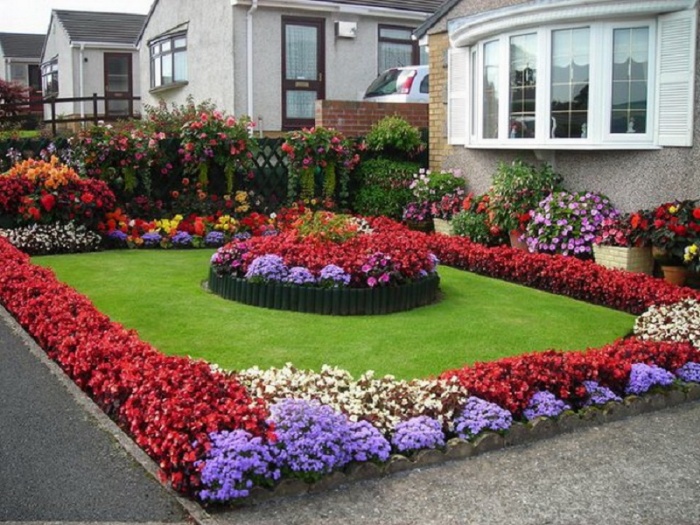
The shape and location of the flower bed in the country affects the choice of plant height. A strict and narrow ridge is often filled with plants with the same height within 15-40 cm. For a round flower garden, a flower bed with tall plants in the center is suitable, then medium-sized specimens are planted, the outer circle is formed by undersized species. A mixborder near a fence or building wall is also equipped with plants of various heights, but according to a different principle: in the background, flower beds are tall flowers or a neat shrub with a gradual transition to medium-sized and then undersized species.
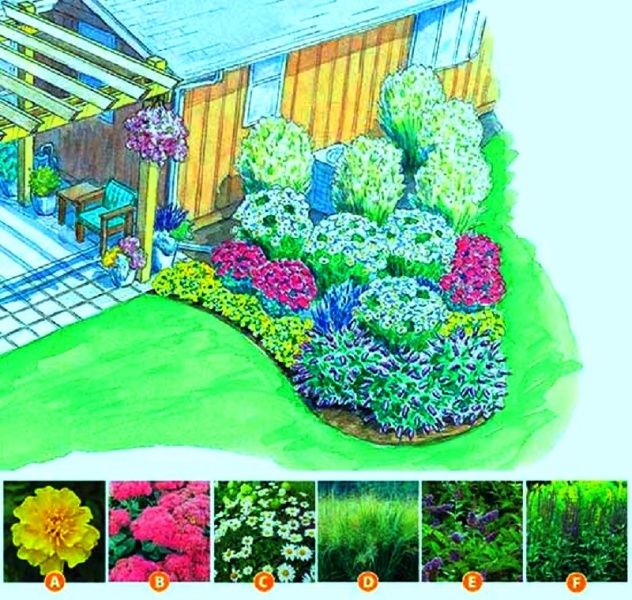
Beginners, in order to arrange a harmonious flower garden at the dacha with their own hands, should first draw up or select a suitable scheme indicating the landing zone of each type. This will make it easier to calculate the need. planting material and the whole process of landscaping the flower garden.
Information about the flowering period
Flowerbeds of continuous flowering transform the cottage, making the site attractive all season. The key condition when drawing up diagrams for such a flower bed is the regular presence of at least one flowering species. For the correct configuration of the scheme, you need to familiarize yourself with the timing of flowering plants:
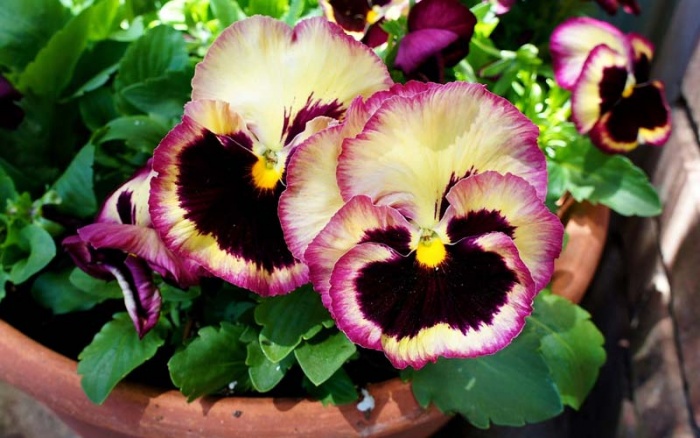
Types of flower beds and choice of location
The place for a flower garden is determined based on its shape. A flower bed in the country can take on various shapes, the most common are the following types:
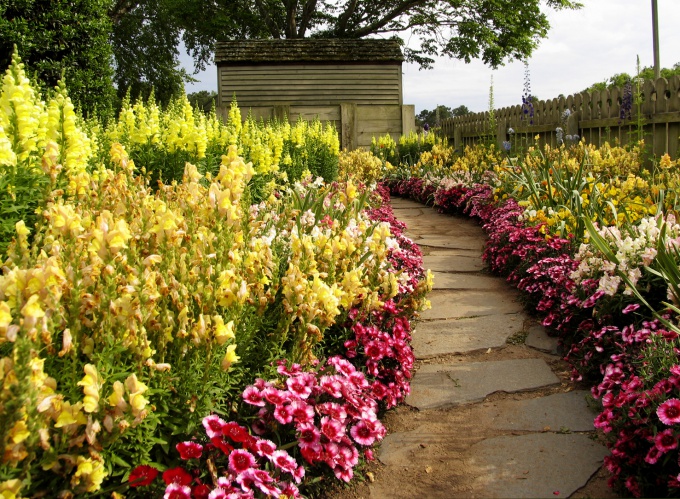
With proper drawing up of a flower garden scheme, even primitive plantings can look spectacular and attract admiring glances. When choosing a flower bed scheme, it is preferable for beginners to stop at flower beds of an irregular nature, such as a mixborder or Alpine slide. The accumulated experience will allow in the future to engage in the design of regular flower beds in the country, where strict geometric pattern is achieved by selecting plants with the same flowering time and observing a certain interval between planting.
To attract butterflies, a mixborder of arborvitae, David's buddley, zinnia, goldenrod and purple echinacea will help.
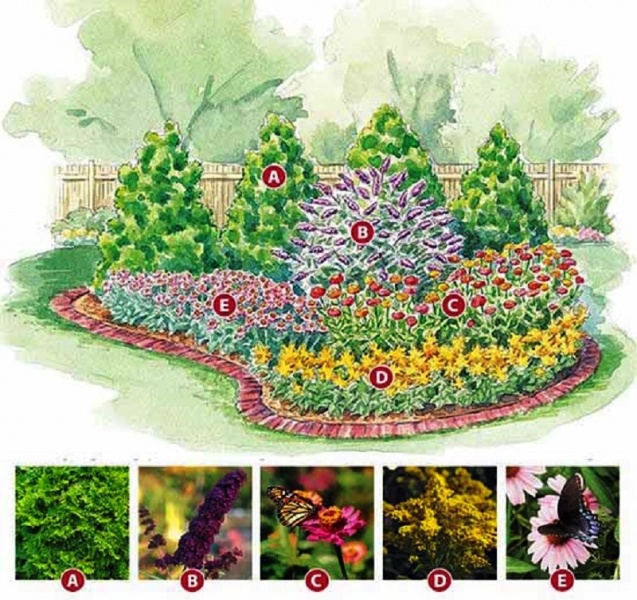
The optimal place for a flower garden is a plot that is well visible from all sides of the cottage. Multi-level plantings are usually arranged near walls or a fence, original decoration the lawn will become an arabesque flowerbed, it is better for beginners to practice on an alpine hill.
Comment! Forming a flower bed scheme for a specific area for summer cottages, shaded and well-lit places are marked on it. This will help to properly equip the flower garden, providing plants optimal conditions for development.
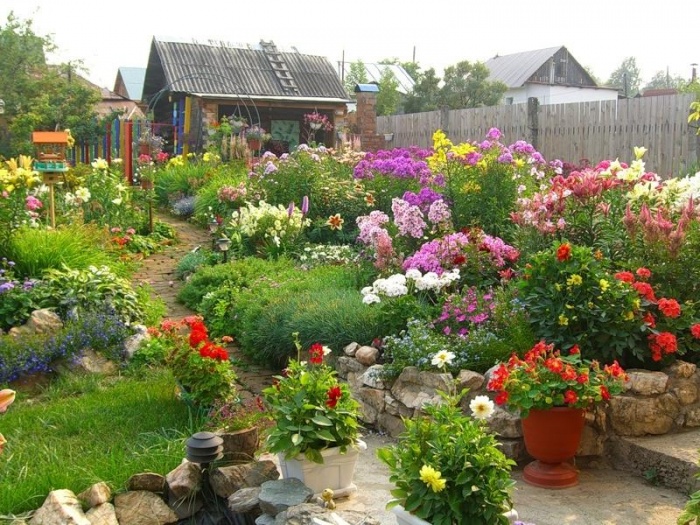
Flower bed preparation
To calculate required amount seedlings, the flower garden scheme is divided into squares with a conditional side of 1 m. After that, the area occupied by each species is calculated. The resulting value is divided by the average landing rate per 1 m 2:
- large plantings 1.0-1.2 m high - 2-3 pieces;
- medium-sized flowers from 40 to 90 cm tall, 4-6 pieces are enough;
- with a plant height of 20-40 cm, 7-9 specimens are planted in a flower garden per 1 m 2;
- for dwarf flowers from 5 to 20 cm, the norm is 16-20 pcs.
To transfer the flowerbed scheme to the dacha site, the landing contours are marked with sawdust, sand or chalk. Before this, the earth is dug up to a depth of 0.4 m, all weed roots are removed and upper layer turf. Specially prepared soil is poured on top for the flower garden.
An example of a successful decoration of the entrance to the cottage is presented in the following diagram, where roses, petunias, thuja, delphinium, lilies, asters and a cuff are used in the design of the flower bed:
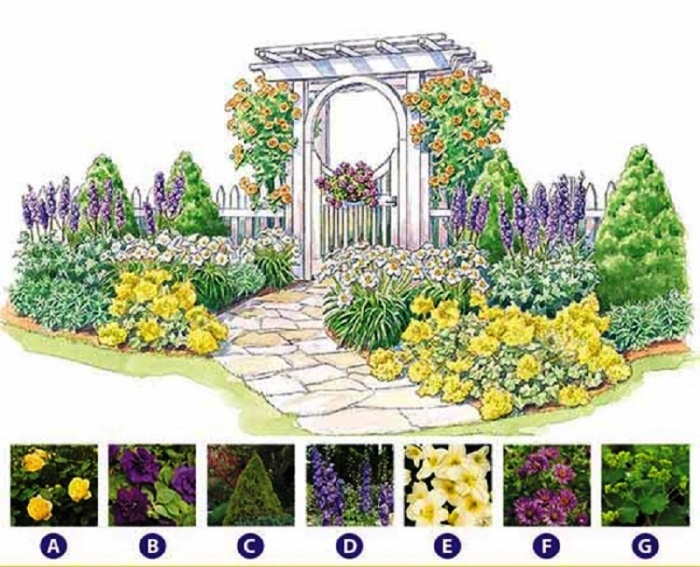
Before planting in a flower garden for 2-3 hours, seedlings need preliminary watering. Optimal time landings in the country - no bright sun i.e. early in the morning or at the end of the day. It is even better to choose the period before the rain. A round-shaped flower garden is filled from the center to the edges, a flower bed located near the fence of a summer house or building begins to be drawn up from the background according to the chosen scheme.
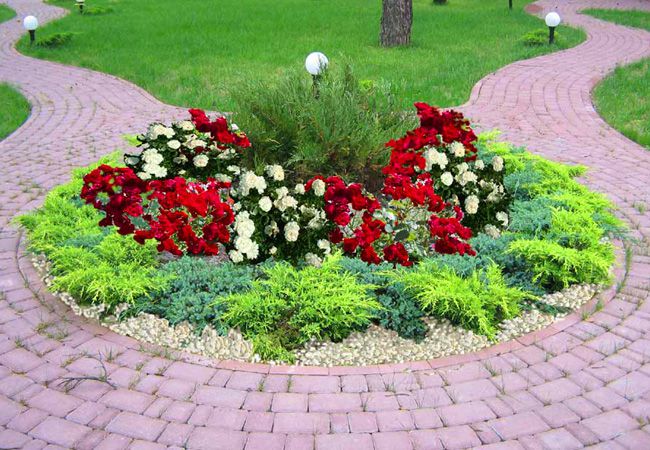
The roots of the seedlings are straightened, after deepening the soil near the neck of the plant is compacted. Upon completion of the work, the flower garden is watered abundantly, tall weak seedlings are propped up with a stick. If a flower has not taken root, it can be replaced at any time with a new specimen from the pot. Don't expect perfect appearance perennial flower garden in the country in the first year of breakdown.
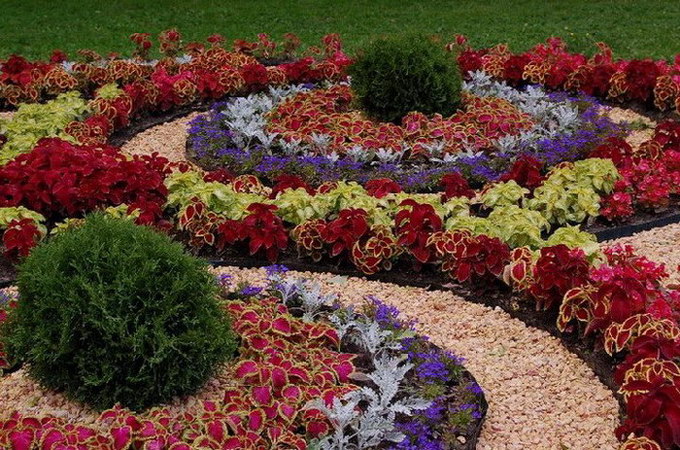
Advice! The unattractive voids of the flower beds are temporarily filled with annual flowers that are suitable for the conditions of detention with the whole scheme.
It looks interesting fragrant flower garden of hibiscus, kufei, penstemon, milkwort and petunia, the diagram of which is shown below:
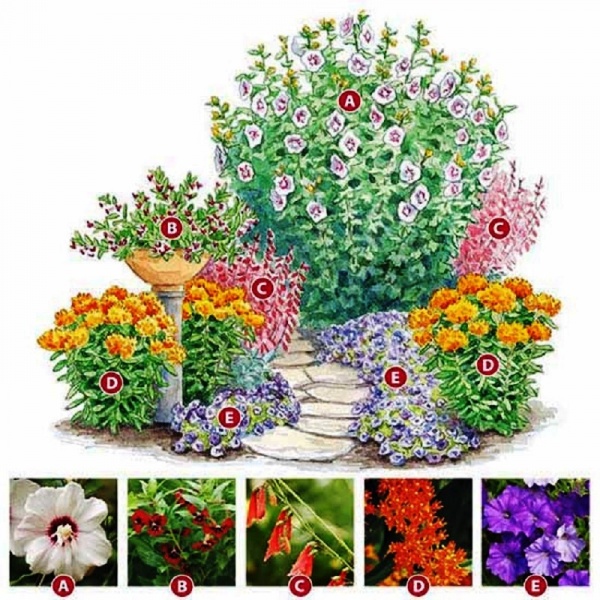
Do not be afraid to make adjustments to the existing flower bed scheme. Replacing one species with another similar in content, changing the shape or area is only welcome.
In addition to the flowering period, when forming a flower garden scheme for a summer residence, the requirements of plants for soil acidity, lighting conditions, as well as their height are taken into account.
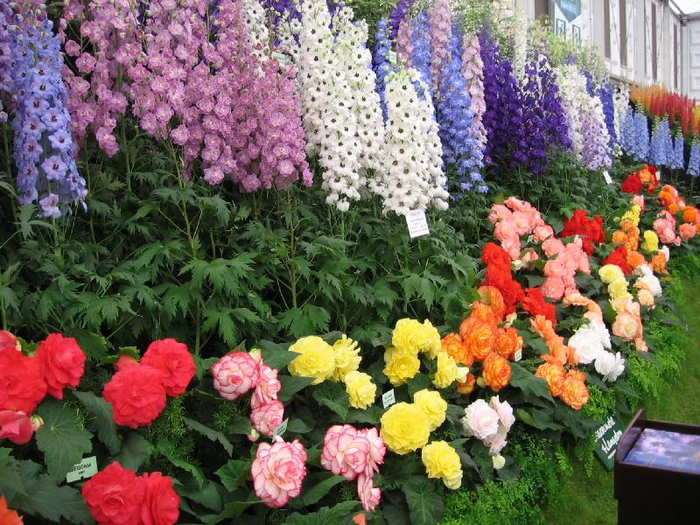
In the group of undersized plants there are unpretentious bulbous specimens: hyacinths, snowdrops, crocuses and muscari. For beginners, as perennials for a flower bed scheme, you can advise a felt stalk, subulate phlox and primrose. Decorate the cottage and bright biennials in the form of daisies, forget-me-nots and pansies. Annual representatives of the flora in the form of undersized marigolds, petunias, purslane are capable of organically complementing the flower garden scheme.
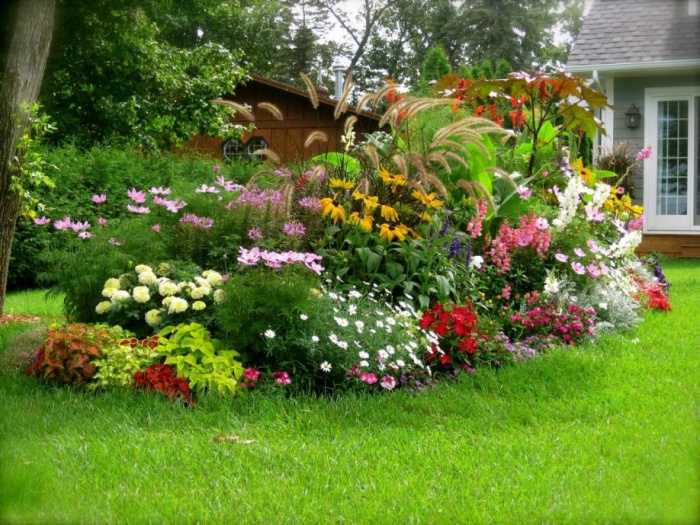
Flowers of medium height are the basic basis of the summer cottage flower garden, therefore it is preferable to choose specimens with a special decorative effect for the scheme. These conditions are met by such perennials:
- daylilies;
- peonies;
- chamomile;
- lilies;
- irises;
- bells;
- phloxes;
- hosts.
Fill the voids in the new flower bed in the country will help annual species: marigolds, asters, lavatera and salvia. In the background or in the center of the flower bed in the scheme, a place is given to tall plants. Aconite is suitable for these purposes, decorative sunflower, clary sage, delphinium, lupine.
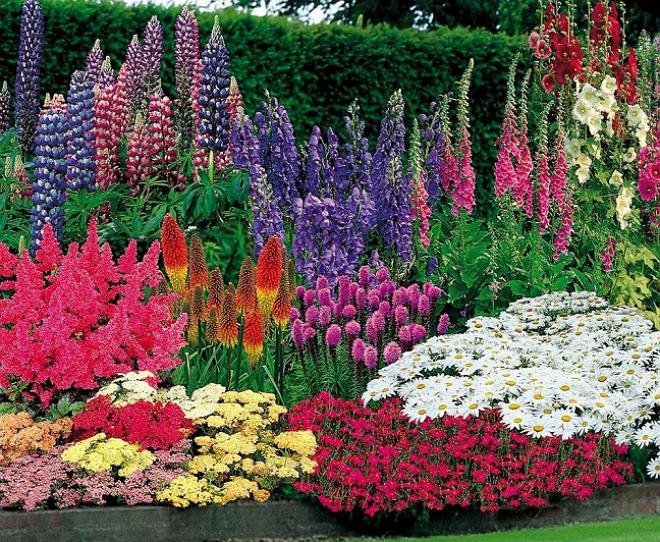
Shaded areas of the cottage will be decorated with flower beds with Japanese anemones, sedum sedum, hosts of all kinds of colors of flowers and leaves, ferns, common primrose and dark geranium. Dacha with acidic soil- a great place to decorate a flower garden with hydrangea, rhododendron, fern. The flower bed scheme may also include herbal carnation, heather, Canadian dogwood, broom or hearty bergenia.
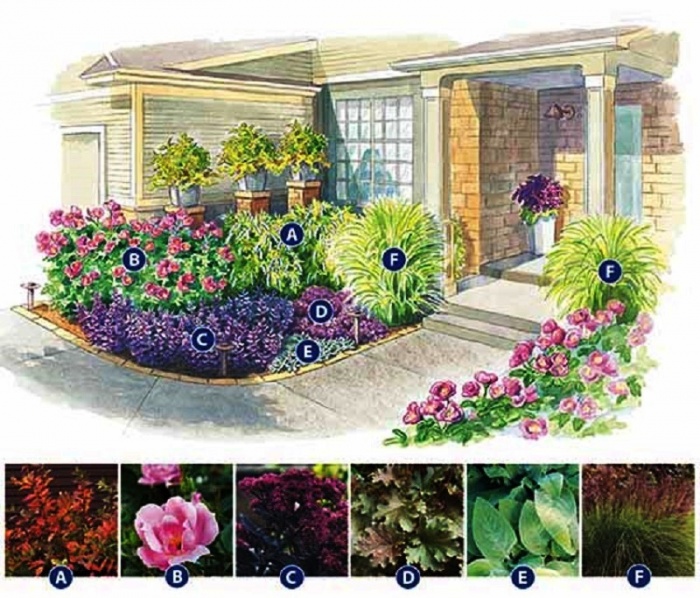
Examples of harmonious flower beds
In conclusion, I would like to give a few more examples of flower beds for summer cottages different levels difficulties.
Scheme the simplest flower bed for teapots will decorate the cottage with a warm palette of pinks, oranges and reds, diluted with a purple tone. Heliotrope arborescens is planted in the background (1). Terry marigolds and Sander's tobacco form the middle tier (in the diagram they are marked with numbers 3 and 2, respectively). The parterre of the flower garden is occupied by a low-growing New Guinean balsam at number 4.
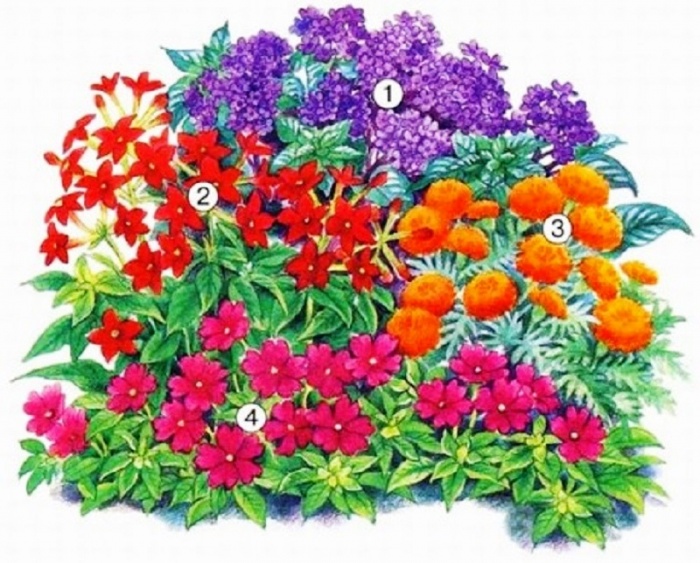
For an extensive mixborder flower garden you will need:
- Giant mallow Pleniflora.
- Ten-petalled sunflower.
- Icelandic poppy.
- St. John's wort
- Lobelia cardinalis.
- Fassen's catnip.
- Bell.
- Katananhe "Blue Cupid"
- Avens
- Sedum Matrona.
- Heuchera Miracle.
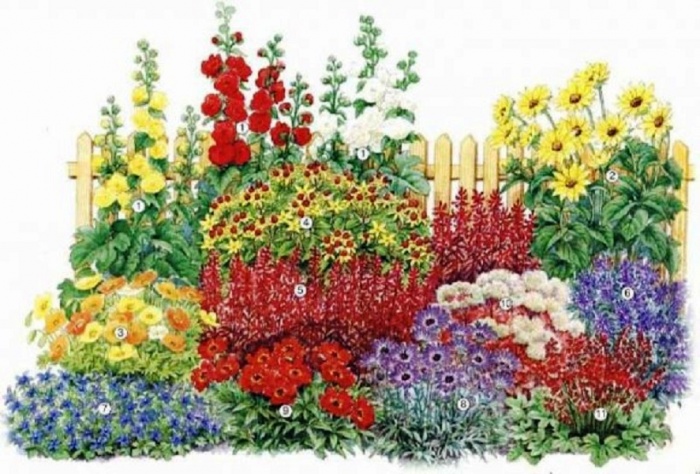
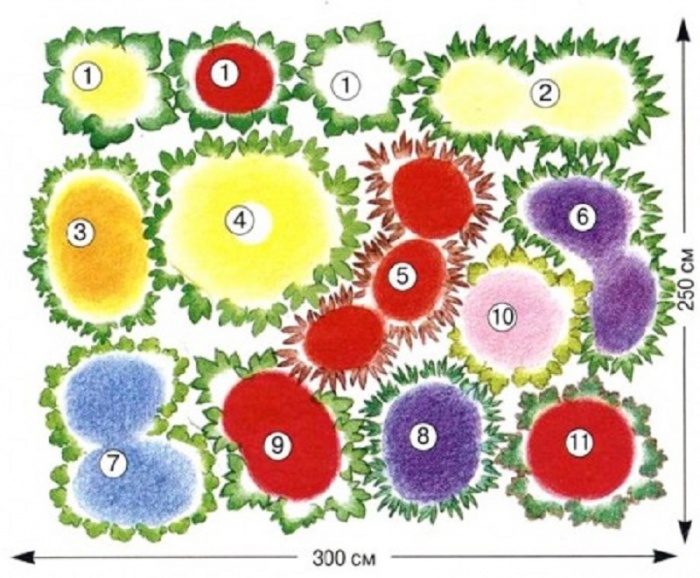
The scheme of a flower garden, resembling a piece of cake in shape, must be prepared:
- The corner of the flower bed is filled with a daylily in the amount of 3 bushes.
- Under the number 2 are silvery leaves of wormwood, 2 copies on each side.
- A dark red bark is planted in the center, 6 pieces are enough.
- The edges of the flower garden are decorated with 3 bushes of geyhera with burgundy leaves.
- On the front of the flower bed there are 5 copies silver leaf cleaner.
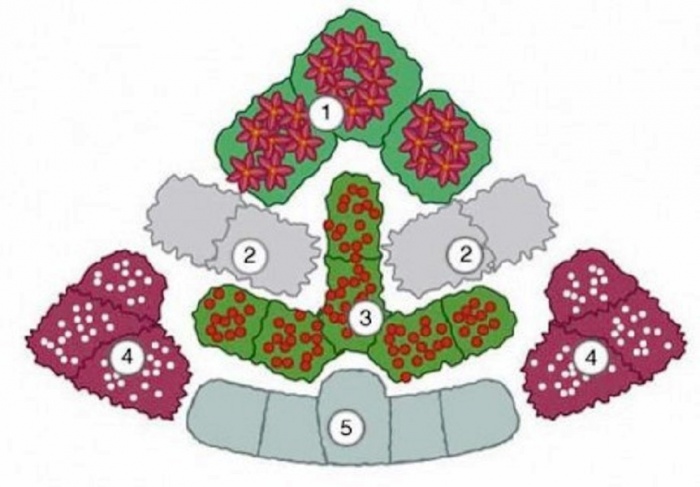
The absence of a reservoir in the country can partially replace a flower bed, the scheme of which contains flowers of blue and blue hues. The bed of the stream imitates large pebbles, painted in Blue colour. Glass beads will add transparency and dynamism. The flower garden is decorated with the following plantings:
- Bamboo leafy.
- Iris bearded.
- Lubelia.
- Creeping tenacious.
- Bell.
- Shaving hybrid.
- Bruner large-leaved.
- Awl-leaved bryozoan.
- Creeping tenacious.
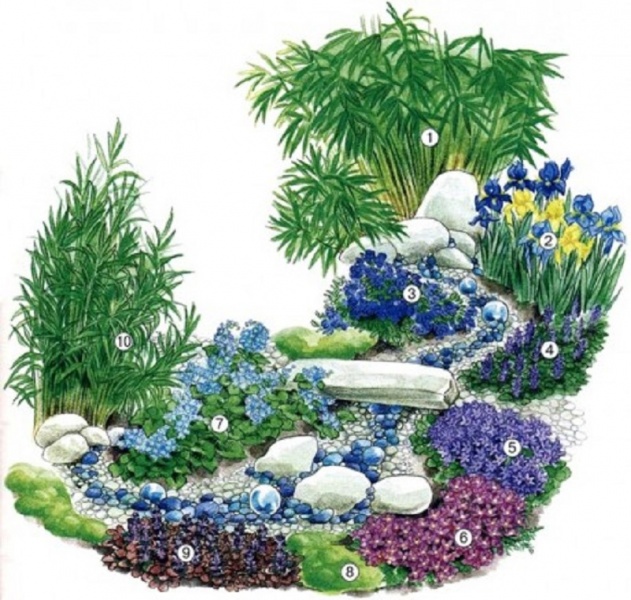
The proposed schemes are not an unshakable postulate. Based on them, in the country you can create your own unique flower garden, pleasing to the eye throughout the warm season.
